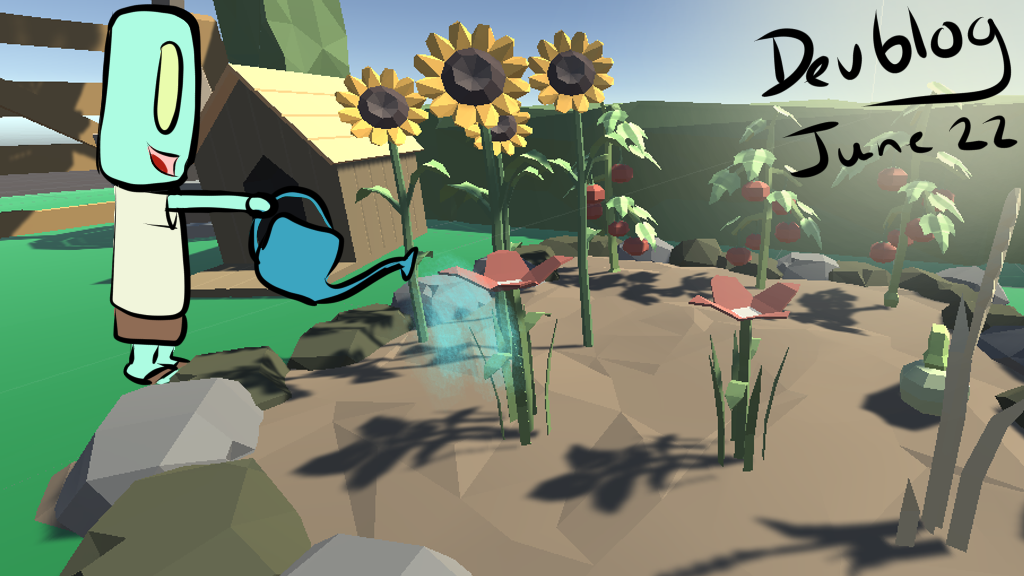
Hey folks! It has been a hot minute since we last spoke. Slightly more than the four weeks I had initially suggested. Instead, I’ve decided to opt for a monthly update, so the last Friday of each month is when you can expect to hear from me! I hope you’ve had a wonderful June and if, like me, you are in the UK, you are enjoying the weird, seasonally warm weather. It’s a strange reality we live in when the weather matching the time of year is unusual, isn’t it? I digress! I’ve not spoken to you all for so long, I just have so many words to give! I’ll try and stick to relevant things in the next paragraph, but I make no promises!
A couple of blogs ago I was raving about my nifty implementation of the dig mechanic, and I went into detail on interfaces and their merits. Well, this month I made good use of that system by adding the last confirmed dig mechanic; the dig-up behaviour. It works as you would expect, when you dig on top of an object that can be dug up, it pops outta the ground and becomes another interactive piece of the world. As you might expect, you get Chaos for this, particularly if you are ruining Ms Jenson’s perfectly arranged floral masterpieces! This is what the initial tests look like:
It feels really satisfying, and I like it a lot. I’ve found myself idly ruining the flowerbeds when I’m supposed to be testing other things on more than one occasion! The way the objects pop-up adds a nice feel to the whole interaction, and it has reminded me of the importance of those little quality of life touches. It’s easy to forget when you are building a game how much of a difference those details make.
So far so good right? A bit of progress in the right direction, always a good start. However the following week I spent most of my time upskilling, rather than developing. I made progress in the 3D modelling course I’m slowly working through, and am feeling a little more confident about my abilities there. I’m by no means game-dev-ready yet, but I can edit things, and work on simple objects for sure! I ended up putting that knowledge to use this week in fact, editing a mesh to split it into pieces so I could create gameplay with them, rather than leave it as one static object. It was a welcome realisation that I have enough knowledge to do that now! Anyway, here is one of the products of the course:

I think it looks pretty swanky if I do say so myself! However, I am not nearly fast enough at modelling to create the wealth of assets needed to make Strays a reality, so the following week I painstakingly grabbed assets from the very many asset packs I’ve accumulated, and added them to the project. Here is the scene I built up so I could import only the assets I needed, rather than bringing in hundreds of assets I’ll never use:

I then used these assets to put together a static version of a level. That is to say, I just put the models in situ, without any gameplay, just to get an idea of what a full level could look like. It was a fun process, and though the art is by no means final, it was nice to see something substantial, that looks like it could be in a finished title! This is how it ended up looking:
However, I haven’t been enjoying the orthographic camera. This is the camera change I talked about in this post. It skewed everything just too much! So I’ve switched back to the perspective camera.
Background for non-techies: Orthographic and Perspective are two different styles of creating an image with a camera. Orthographic means that you take a rectangle in a 2D plane, and anything in that rectangle, no matter how far away, gets drawn directly at that the point on the rectangle it is at. Simple right? The problem is, eyes don’t work that way, and the result in a 3D world will look skewed and will lack perspective. An object will be the same size on the screen whether it is right next to the camera, or a mile away! Orthographic is traditionally used for 2D games, where perspective is unnecessary. Perspective, on the other hand, works a lot more like eyes do. It starts at a single focal point and gets wider as you look further away. This means that if you move closer to an object, it appears to get bigger. Because this is how eyes actually work, this feels a lot more natural in a 3D game, and we can better get a grasp of how far away things are.
The new (old) camera looks a lot better, at the cost of a little real estate on screen, but it has rendered all my camera calculations useless. The camera scaler I worked on zoomed in and out based on how close the dogs were to each other, and moved around to track them. However it never left the bounds of the level, so you were never looking at stuff you couldn’t reach. It’s a lot simpler to bind an orthographic camera to an area like this, and that is how I was achieving the nice scaling effects in the videos above. Now I need to redo those calculations so the camera correctly clamps to the confines of the level, otherwise you will get into situations where half of your screen is outside the play area; not particularly useful!
To wrap up the month, I’ve been adding gameplay to the new level, now lovingly titled “Demo Level”, and making sure all of the gameplay assets I create are stored as prefabs so they can be used elsewhere easily. The result is an early functional version of what could easily be a final level!
It’s fun! There is already a decent amount to do, and with my next task set to be adding some elemental damage (I think I will start with fire, nothing is more chaotic that fire), the amount of ways to interact with this world is only going to increase!
There you have it folks, you are now caught up! I’d love to hear your opinions on anything in this blog, including what you think of the longer-form content, but larger gaps between posts. Your opinion will make a difference, so it you have thoughts, get ’em out! Until next month!
Matt out.
